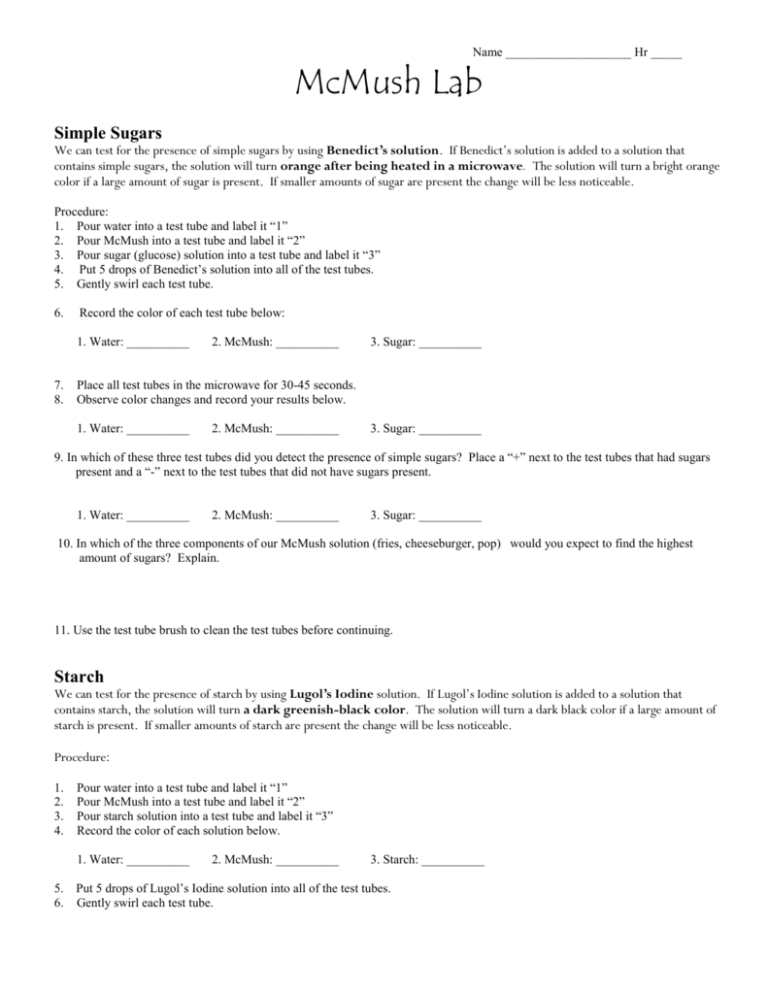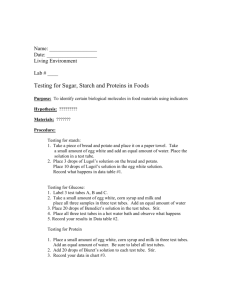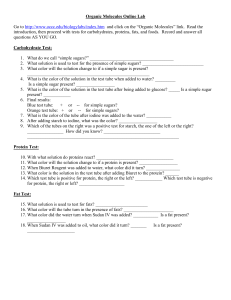McMush Lab 2013
advertisement

Name ____________________ Hr _____ McMush Lab Simple Sugars We can test for the presence of simple sugars by using Benedict’s solution. If Benedict’s solution is added to a solution that contains simple sugars, the solution will turn orange after being heated in a microwave. The solution will turn a bright orange color if a large amount of sugar is present. If smaller amounts of sugar are present the change will be less noticeable. Procedure: 1. Pour water into a test tube and label it “1” 2. Pour McMush into a test tube and label it “2” 3. Pour sugar (glucose) solution into a test tube and label it “3” 4. Put 5 drops of Benedict’s solution into all of the test tubes. 5. Gently swirl each test tube. 6. Record the color of each test tube below: 1. Water: __________ 7. 8. 2. McMush: __________ 3. Sugar: __________ Place all test tubes in the microwave for 30-45 seconds. Observe color changes and record your results below. 1. Water: __________ 2. McMush: __________ 3. Sugar: __________ 9. In which of these three test tubes did you detect the presence of simple sugars? Place a “+” next to the test tubes that had sugars present and a “-” next to the test tubes that did not have sugars present. 1. Water: __________ 2. McMush: __________ 3. Sugar: __________ 10. In which of the three components of our McMush solution (fries, cheeseburger, pop) would you expect to find the highest amount of sugars? Explain. 11. Use the test tube brush to clean the test tubes before continuing. Starch We can test for the presence of starch by using Lugol’s Iodine solution. If Lugol’s Iodine solution is added to a solution that contains starch, the solution will turn a dark greenish-black color. The solution will turn a dark black color if a large amount of starch is present. If smaller amounts of starch are present the change will be less noticeable. Procedure: 1. 2. 3. 4. Pour water into a test tube and label it “1” Pour McMush into a test tube and label it “2” Pour starch solution into a test tube and label it “3” Record the color of each solution below. 1. Water: __________ 2. McMush: __________ 3. Starch: __________ 5. Put 5 drops of Lugol’s Iodine solution into all of the test tubes. 6. Gently swirl each test tube. Name ____________________ Hr _____ 7. Observe color changes and record the color of each solution below. 1. Water: __________ 8. 2. McMush: __________ 3. Starch: __________ In which of these three test tubes did you detect the presence of starch? Place a “+” next to the test tubes that had starch present and a “-” next to the test tubes that did not have starch present. 1. Water: __________ 2. McMush: __________ 3. Starch: __________ 9. In which of the three components of our McMush solution (fries, cheeseburger, pop) would you expect to find the highest amount of starch? Explain. 10. Use the test tube brush to clean the test tubes before continuing. Lipids / Fats: Lipids are important because they are used to make up part of the cell membrane of the cells in your body. The amount of fat permitted in ground beef is regulated by law: 30% maximum for regular ground beef and 15% maximum for lean ground beef. The amount of fat in french fries is not regulated. The presence of fats in a substance can be detected by using unglazed paper towel. Fats leave an oily, translucent smear when touched to the paper. 1. 2. 3. 4. 5. 6. Tear off a small piece of paper towel. On the corners of the paper towel write the numbers 1,2, and 3. Place one drop of water on the area marked #1. Place one drop of your McMush on the area marked #2. Place one drop of oil on the area marked #3. Set the paper towel aside for approximately 15 minutes and complete the protein section of the lab. After the paper towel has had time to dry answer the questions below. Hold the paper towel up to the light and look at the 3 spots. 7. In which of these 3 spots did you detect the presence of fats? Place a “+” next to the locations on your paper towel that had fats present and a “-” next to the test tubes that did not have proteins present. 1. Water: __________ 8. 2. McMush: __________ 3. Oil: __________ In which of the three components of our McMush solution (fries, cheeseburger, pop) would you expect to find the highest amount of fats? Explain. Proteins We can test for the presence of proteins by using Biuret’s reagent. If Biuret’s reagent is added to a solution that contains protein, the solution will turn purple. The solution will turn bright purple if a large amount of protein is present. If smaller amounts of protein are present the change will be less noticeable. 1. 2. 3. Pour water into a test tube and label it “1” Pour McMush into a test tube and label it “2” Pour egg albumin (protein) solution into a test tube and label it “3” Name ____________________ Hr _____ 4. Record the color of each solution below. 1. Water: __________ 2. McMush: __________ 3. Egg Protein: __________ 5. Put 5 drops of Biuret’s solution to all of the test tubes. 6. Gently swirl each test tube. 7. Observe color changes and record the color of each solution below. 1. Water: __________ 2. McMush: __________ 3. Egg Protein: __________ 8. In which of the three test tubes did you detect the presence of proteins? Place a “+” next to the test tubes that had proteins present and a “-” next to the test tubes that did not have proteins present. 1. Water: __________ 2. McMush: __________ 3. Egg Protein: __________ 9. In which of the three components of our McMush solution (fries, cheeseburger, pop) would you expect to find the highest amount of proteins? Explain. 10. Use the test tube brush to clean the test tubes before continuing. 11. Look at your paper towel from the lipids/fats test. Record your results. **Clean – up your station. Spray with bleach solution and have your teacher sign you out of lab_______ Sit down and answer the questions below. Summary Questions: Fill in the following table Reagent Lugol’s iodine Benedicts Biurets Tests For Original Color + Test Color 1. In the McMush solution, what foods provided the main sources of protein? __________________________ 2. In the McMush solution, what foods provided the main sources of sugars? __________________________ 3. In the McMush solution, what foods provided the main sources of starches? _________________________ 4. In the McMush solution, what foods provided the main sources of lipids? 5. Would we expect water to test “+” for any of the nutrients? ________ 6. If you had a “+” water test what should you do? _______________________________________________ __________________________ ___________________________________________________________________________________ Name ____________________ Hr _____ 7. What is the purpose of the test tube with water? _____________________________________________ 8. A certain food was sweet. A student tested it and the results came out “-” for Benedicts and “-“ for Lugol’s. Explain the results. 9. Water runs off the waxy surface of a leaf. Which test would show “+” for the leaf’s surface? 10. Two foods were tested with Benedict’s. One turned yellow and the other turned dark orange. Explain the results. 11. Mushrooms were tested for all of the macromolecules tested in this lab (Carbohydrates: sugars and starch, Protein, Lipids). All tests came out negative. What do these results tell us about mushrooms?






